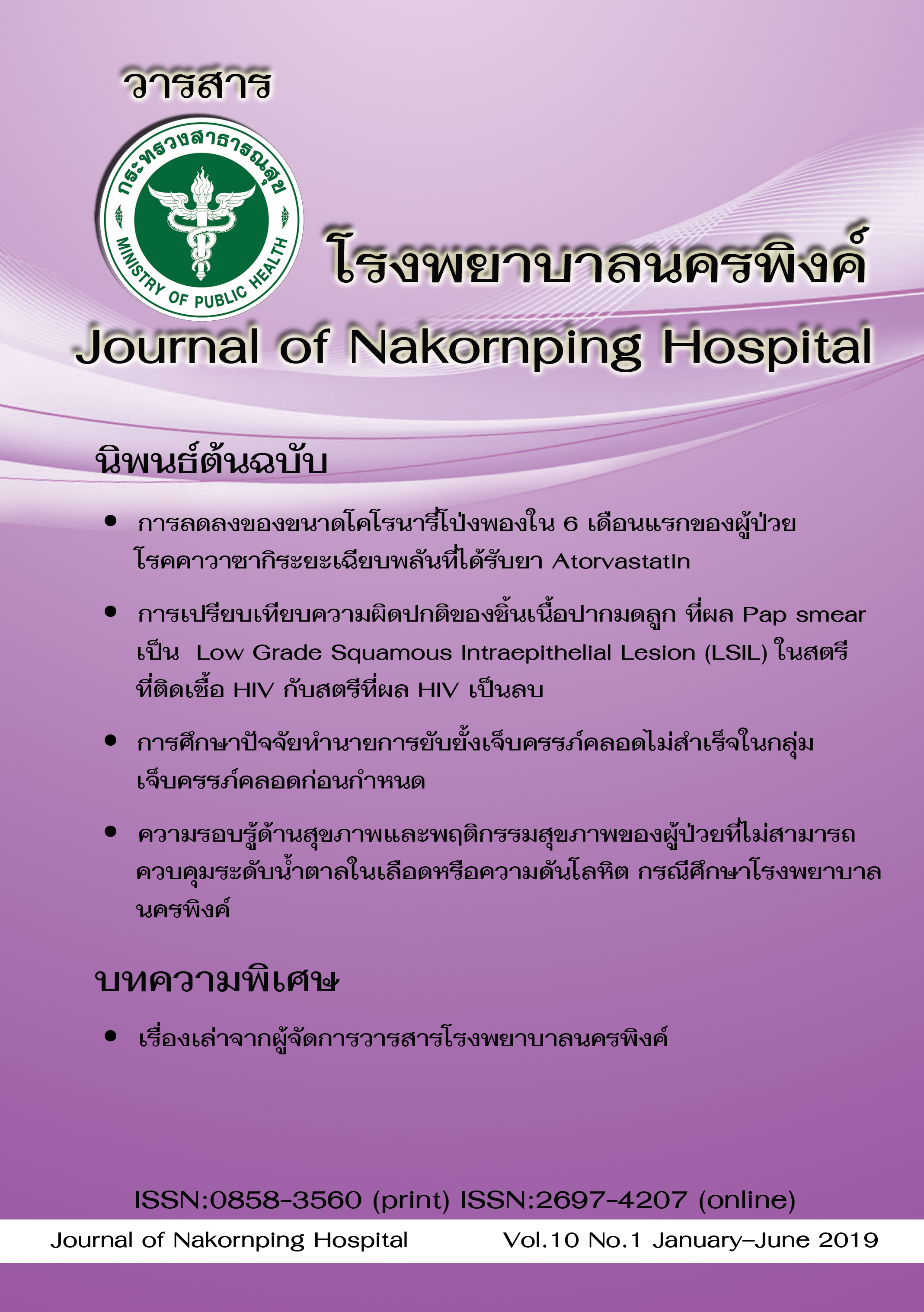Health literacy and health behavior in patients with uncontrolled blood sugar level or blood pressure: a case study of Nakornping Hospital, Chiang Mai
Keywords:
Health Literacy, Health BehaviorAbstract
The descriptive research to study of health literacy and health behavior according to 3E.2S.-Health Literacy Scale of Thai Adult in Diabetic or Hypertension patients with uncontrolled blood sugar level or blood pressure is conducted. The purpose of this study is to evaluate the patients’ knowledge level in health literacy and health behavior for improving quality of patient’s health care. Participants consist of 126 Diabetic or Hypertension patients with uncontrolled blood sugar level or blood pressure who visited the family medicine clinic at Nakornping hospital from 17 December 2018 to 1 March 2019. Patients are asked to complete a questionnaire using 3E.2S.-Health Literacy Scale of Thai Adult (2018-revised edition). This questionnaire, with scoring criteria and interpretation, is designed by Health Education Section, Health Service Support Department, Ministry of Public Health. The qualitative measurement of the 3E.2S.-Health Literacy Scale in the focus group show that the overall Health literacy is fair (65.07%) which indicates that patients have enough health literacy and might had some proper health behavior. The scores of each components are as followed; Needed health knowledge and understanding 70.11%, Accessing information and services 61.11%, Communicating with professionals 63.39%, Managing their health condition 66.08%, Getting media and information literacy 59.52% and Making appropriate health decisions to good practice 71.30%. The Health behavior of the focus group was good (76.22%) indicates that patients had most proper behavior for their own health care. In conclusion, the results of this study suggests to provide health service accessibility which could systematically reinforce health literacy and self-management for both patients and care givers, especially in the lower score components, which are Needed health knowledge and understanding in exercise and emotional management, Getting media and information literacy, Food consumption and exercise behavior.
References
2. สถาบันวิจัยระบบสาธารณสุข. (2541).นิยามศัพท์ส่งเสริมสุขภาพ. ฉบับปรับปรุง แปลโดยพิสมัย จันทวิมล นนทบุรี.
3. Nutbeam, D. (2000). Health Literacy as a public health goal: a challenge for contemporary health education and communication strategies into health 21st century. Health Promotion International. 15(8) printed in Great Britain.
4. Nutbeam, D. (2008). Health Literacy and adolescents: a framework and agenda for future research. Health Education Research. 23(5). Published by Oxford University Press.
5. กองสุขศึกษา กรมสนับสนุนบริการสุขภาพ. (2554). ความฉลาดทางสุขภาพ. นนทบุรี: กระทรวงสาธารณสุข
6. DeWalt, et al. (2004). Literacy and Health outcomes. Journal of General International Medicine. 19: 1228-1239.
7. World Health Organization. (2009). Health Literacy and Health Promotion. Defnitions, Concepts and Examples in the Eastern Mediterranean Region. Individual Empowerment Conference Working Document. 7th Global Conference on Health Promotion Promoting Health and Development. Nairobi, Kenya.
8. สมาคมโรคความดันโลหิตสูงแห่งประเทศไทย. (2558). แนวทางการรักษาโรคความดันโลหิตสูงในเวชปฏิบัติทั่วไป พ.ศ. 2555 ฉบับปรับปรุง พ.ศ. 2558. แหล่งที่มา; http://www.thaihypertension.org/files/GL%20HT%202015.pdf
9. สมาคมโรคเบาหวานแห่งประเทศไทย ในพระราชูปถัมภ์สมเด็จพระเทพรัตนราชสุดาฯ สยามบรมราชกุมารี. (2560). แนวทางเวชปฏิบัติสำหรับโรคเบาหวาน 2560. แหล่งที่มา; http://www.dmthai.org/index.php/knowledge/healthcare-providers/cpg/443-guideline-diabetes-care-2017
10. กองสุขศึกษา กรมสนับสนุนบริการสุขภาพ. (2561). การเสริมสร้างและประเมินความรอบรู้ด้านสุขภาพและพฤติกรรมสุขภาพ ฉบับปรับปรุง ปี 2561. นนทบุรี: กระทรวงสาธารณสุข
11. เบญจมาศ สุรมิตรไมตรี. (ออนไลน์). (2558). การศึกษาความฉลาดทางสุขภาพ (Health Literacy) และสถานการณ์การดำเนินงานสร้างเสริมความฉลาดทางสุขภาพของคนไทยเพื่อรองรับการเข้าสู่ประชาคมอาเซียน. แหล่งที่มา: http://www.mfa.go.th/dvifa/contents/filemanager/files/nbt/nbt5/IS/IS5073.pdf (23 เมษายน2558)
12. อังศินันท์ อินทรกำแหง. (2556). การสังเคราะห์และการพัฒนาดัชนีความรอบรู้ด้านสุขภาพของคนไทย อายุ 15 ปีขึ้นไป ในการส่งเสริมด้านอาหาร ออกกำลังกาย จัดการอารมณ์ งดสุราและสูบบุหรี่.
13. พิทยา ไพบูลย์ศิริ. (2561). ความรอบรู้ด้านสุขภาพและพฤติกรรมสุขภาพ 3อ 2ส ของผู้บริหารภาครัฐจังหวัดพระนครศรีอยุธยา. วารสารสมาคมเวชศาสตร์ป้องกันแห่งประเทศไทย. 8(1): 97-107.
14. อภิญญา บ้านกลาง. (ออนไลน์). ปัจจัยที่มีผลต่อพฤติกรรมสุขภาพของผู้ป่วยเบาหวานชนิดที่ 2 ในเขตรับผิดชอบโรงพยาบาลส่งเสริมสุขภาพตำบลศิลา อำเภอเมือง จัวหวัดขอนแก่น. แหล่งที่มา: http://odpc7.ddc.moph.go.th/journal/files/08อภิญญา.pdf
15. เนาวรัตน์ จันทานนท์. (ออนไลน์). พฤติกรรมการดูแลตนเองของผู้ป่วยโรคความดันโลหิตสูงในอำเภอเมือง จังหวัดชุมพร. แหล่งที่มา: http://www.resjournal.kku.ac.th/abstract/16_6_749.pdf
Downloads
Published
How to Cite
Issue
Section
License
The articles that had been published in the journal is copyright of Journal of Nakornping hospital, Chiang Mai.
Contents and comments in the articles in Journal of Nakornping hospital are at owner’s responsibilities that editor team may not totally agree with.



